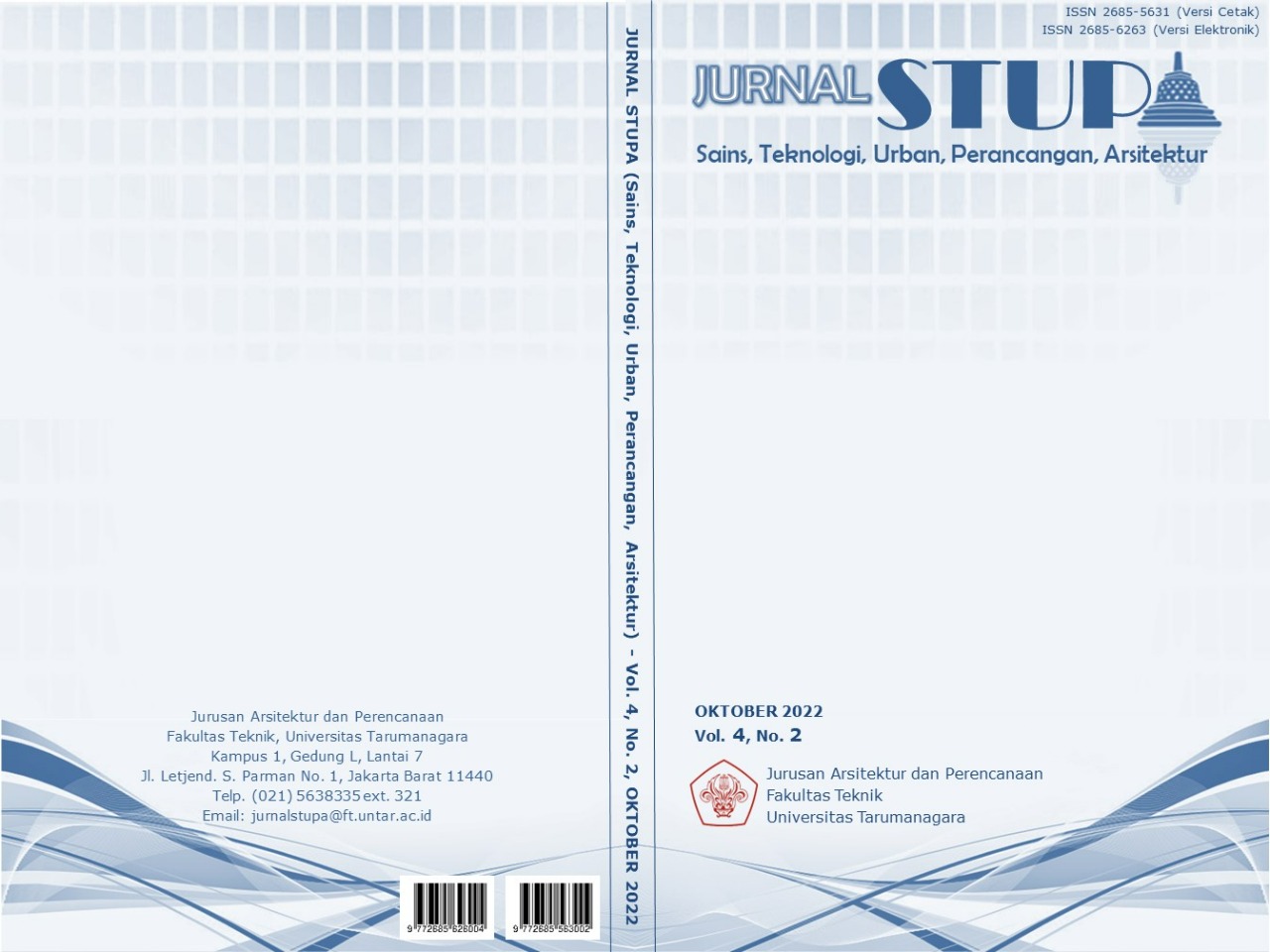FESTIVAL BUDAYA SEBAGAI PEMBANGKIT IDENTITAS KAWASAN BUDAYA DAN SEJARAH MESTER DI JAKARTA TIMUR
Main Article Content
Abstract
Jatinegara is one of the areas known for its history of land ownership by Cornelis Meester, with the Pasar Lama Chinatown, the second-largest after Glodok in Jakarta. The image of a City following Lynch (1960) consists of 5 elements namely paths, edges, areas, nodes, and signs. The physical constituents of the city image play a role in forming regional memory in urban space. However, unfortunately this area has been neglected identity has also disappeared. Festivals as a cultural and historical phenomenon in urban life that can help rebuild the identity of the threatened area. The study used qualitative methods with descriptive analysis. Withal, the site selection method uses urban acupuncture and narrative architecture. The study founds the location in the Old Market triangle area was the most dominant physical and mental degradation area. Problems around the site riposted with a narrative architecture strategy at the memory festival. The Mester Memory Festival answers issues such as the lack of green open space in settlements, social interaction with the natural environment, the threat of losing cultural and historical character, and the economic crisis of underdeveloped retail. The main programs offered are in the form of permanent and non-permanent exhibitions, significant festivals, workshops, and window shopping as well as retail that has a high degree of flexibility to answer the region’s challenges in the future.
Keywords: city memory; festival; identity
Abstrak
Jatinegara merupakan salah satu kawasan yang dikenal dengan sejarah kepemilikan tanah Cornelis Meester dahulunya dengan pecinan Pasar Lama yang terbesar kedua di Jakarta setelah Glodok. Menurut Lynch (1960) citra kota terdiri atas 5 unsur yaitu jalur, tepian, kawasan, simpul, serta pertanda. Unsur-unsur fisik citra kota berperan dalam membentuk memori kawasan pada ruang kota. Namun, sayangnya kawasan ini sudah terbengkalai sehingga identitasnya ikut menghilang. Festival dilihat sebagai sebuah fenomena budaya dan sejarah di kehidupan masyarakat kota yang dapat membantu membangun kembali identitas kawasan yang terancam. Penelitian menggunakan metode kualitatif dengan analisis deskriptif. Selanjutnya metode pemilihan tapak menggunakan urbran acupuncture serta menggunakan metode perancangan arsitektur narasi. Hasil penelitian menemukan lokasi pada kawasan segitiga Pasar Lama yang paling dominan mengalami degradasi fisik maupun mental. Permasalahan di sekitar tapak terjawab dengan strategi arsitektur narasi pada festival memori. Festival memori di Mester menjawab permasalahan seperti kurangnya RTH di permukiman, kurangnya interaksi sosial dengan lingkungan alam, terancam hilangnya karakter kawasan budaya dan sejarah, serta krisis ekonomi akan retail yang tidak berkembang. Program utama yang ditawarkan berupa pameran tetap dan tidak tetap, festival utama, workshop dan window shopping serta retail yang memiliki tingkat fleksibilitas tinggi untuk menjawab tantangan kawasan di masa depan.
Article Details

This work is licensed under a Creative Commons Attribution-NonCommercial-ShareAlike 4.0 International License.
This work is licensed under a Jurnal Sains, Teknologi, Urban, Perancangan, Arsitektur/ STUPA Creative Commons Attribution-NonCommercial-ShareAlike 4.0 International LicenseReferences
Deng, F. M. (1995). War of Visions: Conflict of Identities in the Sudan. Washington, DC: Brookings
Google Maps, 2022, Peta View Udara Lokasi Perancangan Bali Mester, Jakarta Timur, diunduh 15 Februari 2022, https://www.google.com/maps/place/Pasar+Bali+Mester+Jatinegara/@-6.2166643,106.8617198,17z/data=!4m13!1m7!3m6!1s0x2e69f37f6510d615:0x6a783071d4d90f7d!2sBali+Mester,+Jatinegara,+East+Jakarta+City,+Jakarta!3b1!8m2!3d-6.2191246!4d106.8657771!3m4!1s0x2e69f38048dc2ca1:0x75f284afae17034a!8m2!3d-6.2159419!4d106.8652364
Hillier, B, A Penn, J Hanson, T Grajewski, J Xu. (1982). Natural movement: or, configuration and attraction in urban pedestrian movement. Unit for Architectural Studies, Bartlett School of Architecture and Planning, University College London WC1H 0QB, England.
Jakarta Satu, 2022, Peraturan Tata Ruang Kota Jakarta Timur, diunduh 24 Februari 2022, https://jakartasatu.jakarta.go.id/portal/apps/sites/#/public
Jenkins, R. (1996). Social Identity. London: Routledge.
Kaepler, A. L. (1987). Pacific Festivals and Ethnic Identity. Time Out of Time: Essays on the Festival.
Kostof, S. (1991). The City Shaped. London: Thames & Hudson.
Lerner, J. (2011). O Urban Acupuncture: Social Enterprise Article. Harvard Business Review
Lynch, K. (1960). The Image of The City Cambridge. MIT Press.
Lynch, K. (1981). A theory of good city form. MIT Press, Cambridge, MA.
Moleong, J. L. (1999). Metodologi Penelitian Kualitatif. Bandung: Remaja Rosdakarya.
Sanchez, dkk. (2017). Architecture, Festival and the City. Inggris: School of Architecture and Design, Birmingham City University.
Sulistyo, A. (2020). JAKARTA DARI MASA KE MASA: KAJIAN IDENTITAS KOTA MELALUI TINGGALAN CAGAR BUDAYA. Berkala Arkeologi Sangkhakala 23(1), 1-17, Medan, Indonesia, https://doi.org/10.24832/bas.v23i1.387.
Sutanto, A. (2020). Peta Metode Desain. Universitas Tarumanagara, Jakarta
West, D. (2011). ‘Urban acupuncture’ touted for cash-strapped cities. New Urban Network.



